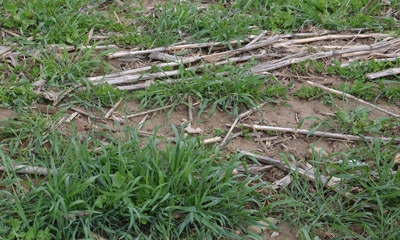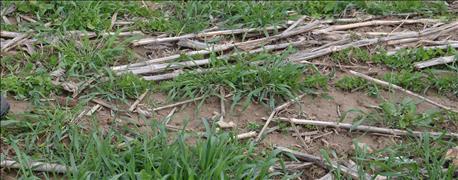
Garrett Dobson has several reasons why he prefers cereal rye as a cover crop. One of them centers around the potential for herbicide carryover. He generally feels there is less risk with cereal rye, which can be planted later in the fall, even into November.
Dobson farms near Rensselaer with a partner, Gary Streitmatter. His crop mix typically consists of non-GMO soybeans, popcorn and mint. This mix means he needs to pay close attention to which herbicides he applied on the crops and when he applied them before deciding when to come back with cover crops, and which ones to seed.

BEWARE OF HERBICIDE CARRYOVER: While this cover crop stand is acceptable, it also may be thinner than you'd like. Herbicide carryover could have contributed to this mediocre stand.
Dan Perkins, technician with the Jasper County Soil and Water Conservation District and often known in the area as the "cover crop guy," says following the same steps Dobson follows when addressing potential herbicide carryover to a cover crop seeding is good advice for anyone, no matter which commodity crops they raise. Perkins is also a local watershed director and an Indiana Certified Crop Adviser.
The later you plant and the later you spray for weeds, the more important the issue becomes. Many people were forced to plant and spray later than they normally would in 2016 due to wet weather at various times.
One source to check out for help with cover crops is this table prepared by Penn State University researchers. The table lists herbicides, use rates, cash crop restrictions for plant-back and potential for carryover into fall cover crops. It classifies various cover crop species following specific herbicides and rates them as "OK to plant" or having "concerns" following that chemical at that rate. To zero in further, consult your herbicide label, and factor in when you made the application.
Here are three examples using the Penn State table.
Example 1. You applied Authority 75DF or Spartan 4F at 4 ounces per acre in soybeans.
You should not expect problems seeding cereal rye or annual ryegrass following this application. However, there is concern if you’re including small-seeded legumes, mustards or sorghum. If you’re coming back with legumes in a cash crop situation, such as alfalfa, the restriction is 12 to 24 months.
Example 2. You applied Assure II/Targa in soybeans at 8 ounces per acre.
According to Penn State research, you should be OK to plant most broadleaf cover crop species. However, there is concern for carryover with all grasses if you seed at less than 120 days since application, or if you apply higher rates than the recommended rate. If you applied the herbicide June 15, that means you wouldn’t want to risk seeding grasses until Oct. 15. In most areas, that eliminates most grass-type cover crops except cereal rye.
Example 3. You applied Harness 7E, Degree or Warrant for corn. The active ingredient of concern is acetochlor.
The table says most cover crops should do fine. If there is a concern, it may be about food residue rather than crop injury. There is a four-month restriction to planting wheat as a cash crop.
Perkins notes that Purdue University is also doing research on cover crops and herbicide carryover. Check with your local Extension educator to learn more.
About the Author(s)
You May Also Like




